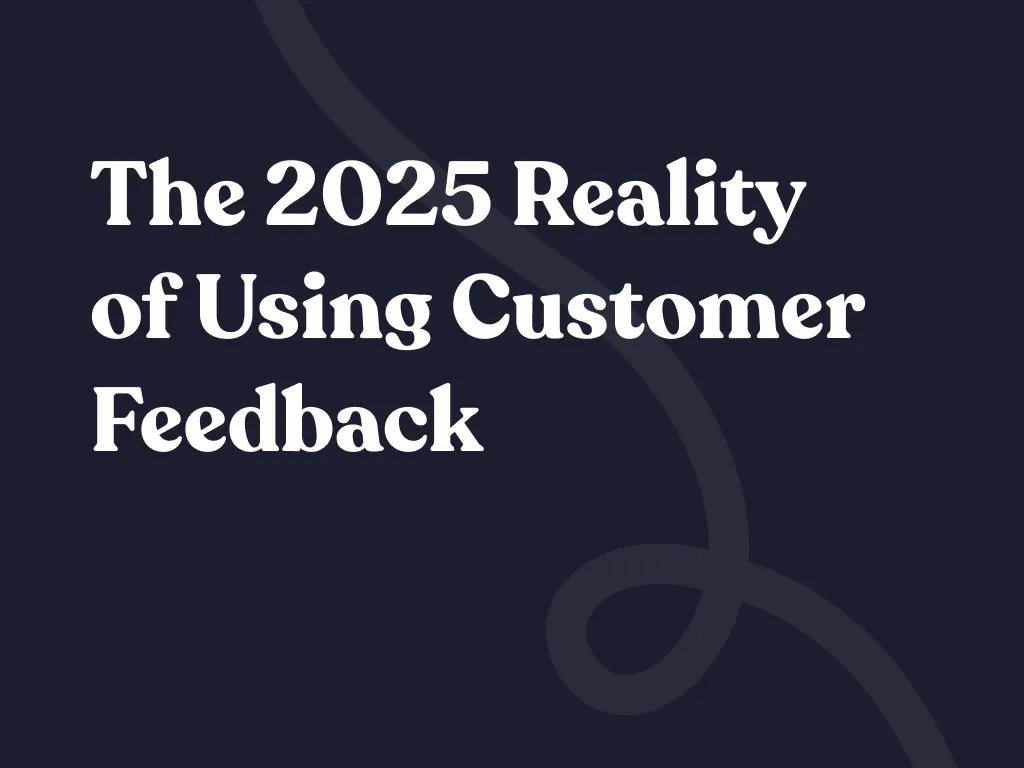Table of Contents
Today, businesses build around a customer-centric framework, placing tremendous value on understanding how their audience feels about their products and services. As they should—without customers there isn’t a viable business and without happy customers there’s no path for growth.
For the customer-obsessed, customer sentiment analysis naturally becomes appealing—a process of using natural language processing (NLP) to analyze customer feedback and gauge overall sentiment (positive, neutral, or negative). On the surface, this sounds like a must-have tool. Understanding how customers feel should be the cornerstone of every product and customer service (CS) decision, right?
But as crucial as customer sentiment analysis may seem, relying on it alone isn’t enough to drive meaningful improvements to a customer’s experience or the products they’re buying. Sentiment analysis can help surface general impressions but often lacks the granularity and specificity needed to make actionable changes that address root causes of customer dissatisfaction.
But first, what is customer sentiment analysis?
Before we get to the meat of this article, let’s briefly clarify what customer sentiment analysis actually is. It’s a technique that uses machine learning and NLP to interpret customer feedback—whether from social media, reviews, surveys, or support tickets—and classifies it into broad categories of sentiment: positive, negative, or neutral. Some more advanced tools can recognize and tag other nuanced emotions.
What does this look like? Well, a customer might leave the following review: "I loved the new features in the app update, but it kept crashing when I tried to complete my purchase." In this instance, the tool might detect a mixture of positive and negative sentiments, with a potential tilt towards frustration because of the crash.
Businesses often find themselves stuck in a limbo of having sentiment data without knowing how to act on it in ways that genuinely improve customer experiences.
The limitations of sentiment analysis alone
At first glance, knowing whether customers are happy or frustrated seems powerful. But the problem is that sentiment analysis often leaves a lot of unanswered questions. For example, if sentiment analysis tells you that 70% of customers are unhappy, what do you do next?
Here are some key limitations when relying solely on customer sentiment analysis:
Broad categorization of feedback
Sentiment analysis will often categorize feedback into generic buckets—positive, negative, or neutral—which lacks actionable detail. It’s a high-level understanding, but high-level rarely ever fixes problems. If sentiment analysis reveals an increase in negative feedback after a product launch, it can’t pinpoint the specific issues driving that negativity, such as bugs, confusing UX, or missing features.
Lack of prioritization
Even if you know customers are unhappy, not all negative feedback should be treated equally. Some issues might be minor annoyances, while others could be major pain points that impact customer churn. Customer sentiment analysis doesn’t tell you which problems need immediate attention and which can be deprioritized.
No clear next steps
What do you do after sentiment analysis reveals a wave of negativity or customer dissatisfaction? The data doesn’t tell you what actions to take. It’s up to teams to sift through feedback, make sense of it, and find solutions manually. We’re talking widespread inefficiencies, wasted resources, and the possibility that the core issue isn’t properly addressed.
Moving beyond sentiment: The need for intelligent feedback grouping and actionable insights
To drive real change, customer sentiment analysis needs to be used in tandem with advanced AI platforms that can automatically group feedback into specific categories, prioritize issues based on impact, and surface actionable insights. Here’s why this holistic approach is necessary to elevating customer experience (CX) and pushing the bounds of product development.
1. Intelligent feedback grouping
Simply knowing that feedback is positive or negative isn’t enough. Businesses need to understand the specific issues driving customer sentiment. This is where AI-powered feedback analytics platforms that automatically group feedback into categories come into play. Ones like, Unwrap.
Instead of lumping together all negative sentiments, a customer feedback platform driven by AI would group negative comments into specific issues—such as “checkout process failures,” “app crashes,” or “customer service response times.” Teams could then quickly identify the exact pain points affecting customer satisfaction.
But they don’t stop there. Platforms like Unwrap can help sort feedback by product, region, or feature set, offering more precise insights that allow teams to home in on problem areas. This is especially crucial for enterprise-scale companies managing multiple product lines and customer segments.
2. Prioritization based on business impact
Not every piece of customer feedback carries the same weight. Some feedback may point to trivial concerns, while other comments might reveal issues that are driving churn or preventing conversions. Advanced platforms can not only categorize feedback but also tell you how many customers have expressed the same problem, ensuring that the most urgent and high-volume issues are prioritized.
For example, an AI-driven platform might surface insights like: "27% of customers are mentioning that the app won’t let them login” then go on to share, “...and half of these customers abandon the product.” Armed with this knowledge, the product team can prioritize resolving bugs in their app code before focusing on less critical matters.
3. Actionable insights and next steps
One of the biggest challenges product and CS teams face is knowing how to act on feedback. Customer sentiment analysis on its own tells you what customers feel, but not what to do about it. This is where AI-driven platforms that surface actionable insights take things to the next level.
Take an advanced system that can analyze feedback related to slow response times from customer support agents. Instead of just highlighting the negative sentiment, the platform could alert you to unusual spikes in feedback related to this topic.
And the best tools can integrate with existing systems, allowing teams to take immediate action—whether it’s generating a task in a project management tool or alerting developer teams to the specific app update that caused a spike in complaints. By closing the feedback loop, teams can reduce the time between incident detection and resolution—minimizing the impact on customer experience.
Customer feedback management is changing—and AI is leading the charge
The true value of an AI-powered customer feedback platform lies in how it shifts the way teams operate. Instead of reacting to generalized sentiment data, companies that use it can now:
- Identify specific problems: Get detailed and nuanced feedback on exactly what customers are struggling with
- Prioritize based on customer impact: Know which issues are affecting the business’s bottom line—whether it’s conversion rates, churn, or CSAT scores—and allocate resources accordingly.
- Act faster: Create tasks, alerts, or workflows based on feedback insights, ensuring swift resolution of high-priority issues.
- Be proactive: Leverage real-time analytics and predictive AI models to spot emerging trends before they escalate into unwieldy problems.
It’s not just about understanding customer feelings—it’s about reshaping those feelings into concrete actions that improve product and service delivery.
Customer sentiment analysis is just the tip of the iceberg
In the world of processing feedback data, customer sentiment analysis is helpful. But it’s only one piece of the puzzle.
To drive meaningful change, companies need to look past basic sentiment scores and invest in AI-driven platforms that intelligently group feedback, prioritize issues, and enable actionable next steps.
The future of customer feedback management lies in pairing sentiment analysis with a smart platform that offers you—and your customers—more. It’s maturing from analyzing past customer frustration to preventing future dissatisfaction. Are you going to go with it?
Read how Sunrun embraced the future with Unwrap.






